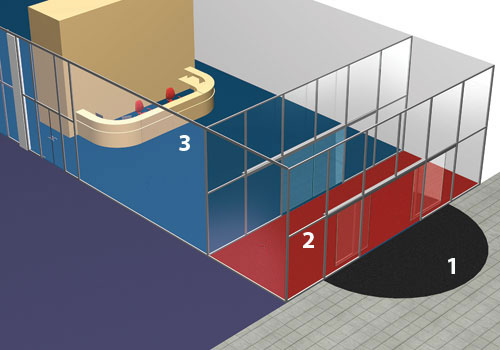The Significance of Entry Flooring Systems
Risk management and liability are also strong drivers for using entrance flooring systems. Building entrances are common sites of slip and fall accidents either because of wet or poorly maintained floors. People who slip on these floors and are hurt often bring lawsuits against the building owner and their insurance companies. It is not uncommon for them to claim large amounts of money as just compensation for injuries, loss of income, pain and suffering among other things. Entrance flooring systems can reduce the likelihood of such accidents by helping to control the build-up of water and keep the entrance floor surface more slip resistant.
Whatever the final reasons are to include an entrance flooring system in a building, properly designing a successful one starts with understanding how it works. From a purely functional stand point, entrance flooring systems need to accomplish four things. These are referred to as the four “R's” of an entrance flooring system. First it must remove dirt, soil and debris from shoes or boots as people enter a building. It does this typically through intentionally irregular shapes in the surface of the flooring to help create friction and clean against the footwear. Second, it must collect and retain the dirt and debris in the flooring to prevent other people from tracking it into the building. Then when the flooring is cleaned or vacuumed, it must readily release the collected and retained dirt and debris to prevent it from being saturated and unable to function as intended. Finally, the entrance flooring must be able to recover as a product so that it continually looks good and functions properly. When evaluating entrance flooring products from different manufacturers, then, it will be important to question how well they each accomplish all four of these functions. If a product doesn't have a successful track record for doing all four of these R's then it will not be effective at achieving the intended maintenance and risk management goals.

Determining where to locate entrance flooring systems in a building is more than just deciding to put it inside the entry door. Instead a comprehensive design is based on identifying and addressing the typical entrance zones of a building. There are commonly three such entrance zones as follows:
Zone 1: This is the very first area of defense against foot-borne soil and water being carried into the building. It is ideally located right outside the building to prevent soil from ever entering the building at all. Where that is not practical, it can also be located immediately inside the doorway. Either way, this is the location to choose the most effective entrance flooring system relative to the degree of foot traffic encountered.
Zone 2: This may be a vestibule or other extended entry area that is immediately beyond the zone 1 entrance area. A secondary entrance flooring system or a continuation of the primary one may be installed here to address soil and water not picked up in zone 1.
Zone 3: As people move out of the defined entrance area, they are typically directed into a lobby or other common area. To be sure that the maximum possible soil and water is removed it may be desirable to extend a form of entrance flooring system in this zone. In certain parts of the country, building owners who have not done this find they resort to using separate entry rugs or mats placed on top of the floor and have them cleaned regularly. These removable mats are not always attractive or consistent with the design intent of the building, nor are they always functional if they become saturated due to high use or bad weather. Selecting and designing a permanent product in this area will help avoid those limitations and improve the appearance overall.
 |
The three common entrance zones of a building. Image courtesy of Forbo Flooring Systems |
The rest of the building: While not an entrance zone, the area throughout the rest of the building can be covered with any of the hundreds of flooring products available. It won't receive entrance flooring but will benefit from being cleaner, safer and better looking than it might have been otherwise without the entrance flooring system in place.
Each of these zones should be looked at during the design phase to determine where each of the boundaries could be located to be the most effective for a particular project or building. It is important to note that different buildings will of course have different needs in terms of usage and zones. An elementary school for example will have different specific entrance flooring needs than an office building will while both of them will have different specific needs from an industrial facility. Nonetheless, all applications can benefit from this simple quick analysis of the entrance zones to determine the best type and style of entrance flooring to design with and specify.
Within the flooring industry, there are two common types of entrance flooring systems available from manufacturers. A rigid grid mat system usually made of aluminum with walking surface material incorporated is what most people think of when talking about entrance flooring systems. These are available in a variety of configurations and usage ratings and may be most appropriate for zone 1 and 2 applications. However, there are also systems which are heavy-duty textile-based mat systems that have a more carpet-like appearance. These are particularly well suited to zone 2 and 3 applications and can provide attractive and effective performance in an extended entrance area of a building. Within each of these types there are options, variations and customization opportunities, but all must first be rated to comply with prevailing codes and standards for entrance, egress and handicapped accessibility.









